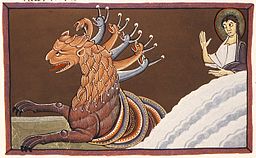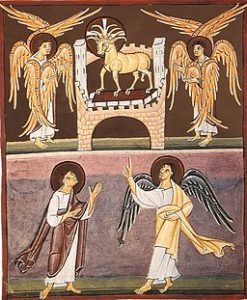 A second option for calculating or reckoning the number of the Beast would be to jump directly to the symbolic meaning of the number 666. Perhaps when John calls for the one with understanding to “calculate” or “reckon” the number of the Beast (Rev. 13:18), he is using such language to call upon the reader to interpret, or decipher the significance of, the number of the Beast. The number of the Beast’s name is clearly a number with a symbolic meaning (Beale, Revelation, 720-9; Smalley, Revelation, 350-3; Minear, I Saw a New Earth, 258). Six hundred and sixty-six is a very suitable number to capture the nature of the Beast and to capture the Beast’s place in a like-minded group of three, the unholy trinity. At the end of the day, both of the options that I have mentioned lead to a focus upon the significance of 666 (see previous post for option one).
A second option for calculating or reckoning the number of the Beast would be to jump directly to the symbolic meaning of the number 666. Perhaps when John calls for the one with understanding to “calculate” or “reckon” the number of the Beast (Rev. 13:18), he is using such language to call upon the reader to interpret, or decipher the significance of, the number of the Beast. The number of the Beast’s name is clearly a number with a symbolic meaning (Beale, Revelation, 720-9; Smalley, Revelation, 350-3; Minear, I Saw a New Earth, 258). Six hundred and sixty-six is a very suitable number to capture the nature of the Beast and to capture the Beast’s place in a like-minded group of three, the unholy trinity. At the end of the day, both of the options that I have mentioned lead to a focus upon the significance of 666 (see previous post for option one).
666 and the Unholy Trinity
Six hundred and sixty-six is the “number of his name” (Rev. 13:17; 15:2). As such, it is the number that refers to the Beast’s name. It is also a number that symbolically refers to the other members of the unholy trinity (that is, the Devil, the Beast, and the False Prophet) at the same time. Revelation 12-13 anticipates the number 666 through its consistent presentation of the false trinity as imitating the true Trinity. For example, the Dragon and the Beast both have seven heads. The Dragon’s seven heads with their seven crowns are an imitation of the Lamb’s seven horns (12:3; 5:6). The Beast was slain and came back to life, just like the Lamb (13:3; 5:9; 1:18). The False Prophet has horns like a lamb, which makes him resemble the Lamb, who also has horns (13:11, 5:6). The unholy trinity or false trinity deceives the world with its various blasphemous words and actions. It presents itself as a power equal to, and even greater than, the true Trinity.
 God’s Number Is 7
God’s Number Is 7
The members of the Holy Trinity are always associated with the number seven. The Spirit is introduced as the “seven spirits of God” (1:4; 4:5; 5:6). The Lamb has seven horns and seven eyes (5:6). God’s wrath takes the form of three sets of seven judgments (7, 7, 7). In short, seven is a common number in Revelation and it is almost always connected with God, the members of the Trinity, and their work. The exceptions occur in Revelation 12:3, 13:1, and 17:3-11. All of the exceptions have to do with the seven heads of the Dragon and the Beast. The Dragon and the Beast’s pretensions to the number seven are decisively undercut by the disclosure of the true number of the Beast and of his name. Wisdom and understanding reveal that 666 is the true number of the Beast and of his unholy trinity (13:18).
Theological Significance of 666
The number 666 provides a significant symbolic statement. It anticipates that the Beast’s claims to be equal to and greater than God will come to naught. He, and the two powers on his side, will not be able to rise up and overthrow God’s Trinity. God’s kingdom does not have anything to fear from the temporary advances of the Beast. The interpretation of the Beast’s seven heads discloses that five have already fallen (17:10). The Beast’s power is already approaching its end. He was already slain at the time of the cross and he will be defeated again when Christ comes back. The coming judgment of God will reveal to all that the Beast’s true number is 666. At that time, the deceptions of the unholy trinity will end. All will see that the unholy trinity falls short of the true Trinity over and over and over, just like each digit of the number 666 falls short of the number 777. Rather than being a cause for alarm for the people of God, the number 666 is a number that points to hope in what the end will reveal.
Sources:
These paragraphs are slightly edited portions of my book:
Paul Hoskins, The Book of Revelation: A Theological and Exegetical Commentary, pp. 258-259 (those pages provide further sources and footnotes that I have omitted above).
